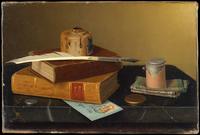East Meets West in 18th-Century Italian Artist’s Letters
'East Meets West in 18th-Century Italian Artist’s Letters’
Elena took part in a one-week curatorial research micro-internship in June 2023, hosted by the University of Oxford National Trust Partnership team and co-supervised by National Trust.
In June 2023, I completed a research internship with the National Trust under the supervision of Dr John Chu and Alice Purkiss. The aim of this internship was to translate the letters of Anna Tonelli, an Italian artist who worked for the Clive family between 1794 and 1802. The Clive family is notable for their significant role in British colonial history and their influential connections with the East India Company. My task was to provide an insight into Anna’s experiences in Britain and India, explore her involvement with the Clive family’s intellectual circle, and contextualise her letters within the broader cultural exchange between Europe and Asia at the turn of the 19th century.
To provide some background on Anna’s life and her art, it’s important to note that her association with the Clive family placed her at the crossroads of European and Asian cultural exchange at a time when global exploration contributed to a profound curiosity about distant lands and a fascination with the exotic. Born in Italy, Anna trained as a portrait painter in Florence and worked in watercolours, oils and pastels. Little is known about her ancestry, but she descended from a family of artists on her father’s side, and she married a violinist named Luigi Tonelli who belonged to a famous Italian family of musicians. Together, Anna and Luigi had two children, but the four were divided when Anna moved to a foreign country with a strange family.
In 1794, when Anna was working as an apprentice to Hugh Douglas Hamilton, an Irish painter working in Rome, she came into contact with an elite circle of British patrons visiting Italy on the Grand Tour. Among them was Robert Clive’s son, Edward Clive, who later became Governor of Madras for the East India Company. Clive liked Anna’s portrait of him enough to ask her to settle in London as a governess to his children and a companion to his wife. Anna accepted and left behind her homeland to join the Clive household, where she served as an art and music teacher to Clive’s daughters for the next eight years.
Between 1798 and 1801, Anna travelled extensively around India with Lady Henrietta Clive and described her impressions in letters written to her confidante, Harriet Anne Bisshopp, a young Gloucestershire woman who married the Sussex landowner Sir Cecil Bisshopp. Anna’s letters not only provide a vivid and intimate glimpse into the Clive family’s travels but also chart the development of her relationship with Lady Bisshopp. Anna advises Harriet on private matters and personal concerns, shares news about mutual friends, recounts amusing anecdotes from her travels, and reminisces about her visits to her picturesque country house. Her letters provide a rich picture of life in early 19th century British India.
My main task as an intern was to render Anna’s letters to Lady Bisshopp into English. I had to first make an accurate transcription, with accompanying notes, and then a full translation. The notes proved to be more crucial to the translation process than I anticipated. Not only did I rely on them to shed light on the historical context and cultural references of the original text, but also to ensure the preservation of Anna’s unique tone and style in the translated version. These notes contained information on her use of her local dialect, Tuscan, her seamless weaving of regional expressions into her prose, and the historical events, epistolary conventions, and literary influences that shaped her writing.
Looking back, my internship was not only a valuable opportunity to apply my language skills practically but also to think more theoretically about the complex relationship between translation and interpretation. Translating Anna’s words from Italian into English was both an enjoyable literary effort and an interpretive puzzle. The scribbles, crossed-out words, and occasional ink blots told stories of their own, offering glimpses into Anna’s thought process and the tangible nature of her connection with Lady Bisshopp. The more I pored over these remains, the more I appreciated the responsibility bestowed upon me to convey Anna’s voice faithfully in the translated text.
Every choice I made, however, a sense of intrigue persisted. The letters revealed intimate details of Anna’s life in Britain and India, but there’s still much we don’t know about the fears, hopes, aspirations and anxieties that remained unexpressed in her correspondence. What were her private thoughts as she navigated the complexities of such different countries? How did she truly feel about leaving her family behind for another in England? Did she question her decision to join the Clive family on their journey across India? Might it be that she found a sense of belonging and love within the family that went beyond mere duty? As a translator, grappling with these unanswered questions left me with both a sense of accomplishment at what I had been able to recover about Anna and an acute awareness of the gaps in her story.
Elena graduated from Oxford in 2023 with a BA in English Language and Literature and an MA in English Literature 1700-1830. As a student, she worked at the intersection of literature and the visual arts with an emphasis on Romanticism.
Image Credit: The Banker's Table. William Michael Harnett
Find out more about the National Trust Partnership here.
Find out more about the TORCH Heritage Programme here.



